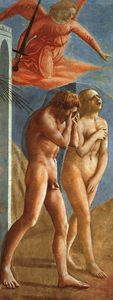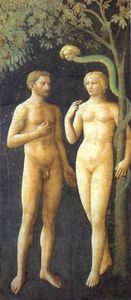Expulsion from the Garden of Eden Analysis
- Date of Creation:
- 1427
- Medium:
- Other
- Support:
- Other
- Subject:
- Figure
- Technique:
- perspective, vanishing-point
- Characteristics:
- humanism
- Framed:
- No
- Art Movement:
- Renaissance
- Created by:
- Current Location:
- Florence, Italy
- Expulsion from the Garden of Eden Analysis Page's Content
- Introduction
- Composition
- Use of color
- Use of Light
- Natural vs. Artificial Imagery
Introduction
The "Expulsion from the Garden of Eden" is remarkably lifelike and stunning. The painting, a rendition of a biblical story, holds both a symbolic and unsettling realistic portrayal of the first humans, Adam and Eve.
Just seen across the Chapel, Masolino's "Temptation of Adam" rests on the opposite wall and it said the Brancacci holds both the end of the Gothic era and the beginning of the Renaissance.
Expulsion from the Garden of Eden Composition
The fresco rests on a long and narrow column which stretches the images. Being placed more than 10 feet off the ground, the viewer of the painting has (weird view as the painting basically consists of only them. And they placed high on the wall).
One of the first three-dimensional paintings, Masaccio uses a vanishing-point across their torsos. The use of the vanishing point drives all of our attention to the naked human bodies.
The bodies are depicted twisted and convulsing. Adam is hunched over with hands covering his face while he steps out from the arch of Eden. His muscles are being stretched and twisted. Eve also is painted in agony with her arms covering her genitals. Her face is difficult to look at.
Expulsion from the Garden of Eden Use of color
Masaccio's use of reddish hues with the figures takes out all lines and gives them a sense of roundness and blends them in with the desolate back ground.
The shading of the angel's clothes is typically Masaccio. With the amount of shading, Masaccio's is taking advantage of the light source coming in from the right side of the painting and adding a touch of glory and beauty.
Expulsion from the Garden of Eden Use of Light
The light in the painting comes from the right side, the wilderness. This technique has many implications adding to the theme of the painting, but also allows the viewer to get a front on view of the characters. Masaccio seems to be pushing the viewer to look right at Eve, which, due to the expression on her face, is almost difficult to look at.
The single source of light allows Masaccio to go into greater detail, such as the muscle indentations, the shading of the angel's clothes, and Adam and Eve's shadows.
Expulsion from the Garden of Eden Natural vs. Artificial Imagery
Masolino's depiction of Adam and Eden in the "Temptation of Adam" is probably more pleasing to the eye while Masaccio's rendition is more effective and striking.
Masaccio's character are not are defined by line or a clear outline of the figures but instead with contrasting colors and heavy areas of shaping and light. With Masaccio's focus on the human form, the muscles and faces especially, he succeeds in displaying theme by raw depiction.
This painting although possibly lacking a total success in linear perspective, pushes reality and appreciation of human form in front of the viewer. There is not much room for imagination as there would have been with earlier paintings. Masaccio's focus on the human body and correct proportions will continue to inspire artists years later as the Florentine Humanism movements continues to grow.
The nudity in the painting must have shocked the viewers at the time. Most of painting was highly idealized and symbolic paintings, and shied away from showing the human form much less nudity.
Cosimo II de Medici demanded that Adam and Eve were covered with fig leaves to hide their nudity. The leaves were removed in 1980s during a cleaning.
Interesting to note, this painting has been used on medical textbooks in the United States.






